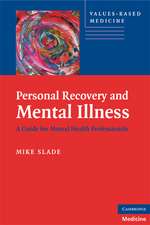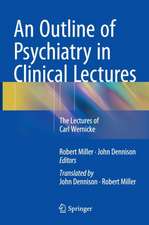Infant Depression: Paradigms and Paradoxes
Autor Paul V. Traden Limba Engleză Paperback – 8 noi 2011
Preț: 719.02 lei
Preț vechi: 756.86 lei
-5% Nou
Puncte Express: 1079
Preț estimativ în valută:
137.59€ • 147.13$ • 114.72£
137.59€ • 147.13$ • 114.72£
Carte tipărită la comandă
Livrare economică 17 aprilie-01 mai
Preluare comenzi: 021 569.72.76
Specificații
ISBN-13: 9781461386650
ISBN-10: 1461386659
Pagini: 356
Ilustrații: XII, 340 p.
Dimensiuni: 155 x 235 x 19 mm
Greutate: 0.5 kg
Ediția:Softcover reprint of the original 1st ed. 1986
Editura: Springer
Colecția Springer
Locul publicării:New York, NY, United States
ISBN-10: 1461386659
Pagini: 356
Ilustrații: XII, 340 p.
Dimensiuni: 155 x 235 x 19 mm
Greutate: 0.5 kg
Ediția:Softcover reprint of the original 1st ed. 1986
Editura: Springer
Colecția Springer
Locul publicării:New York, NY, United States
Public țintă
ResearchCuprins
1 Developmental Psychopathology.- The Perspective of Developmental Psychopathology.- A Developmental Perspective on Depression.- Predictive Validity.- Future Directions: Need for Improved Research and Classification Methods.- Organization of Book.- 2 Correlates of Temperament to Depressive Phenomena.- Case Report.- Individual Differences and Importance of Stability Over Time.- Relationship Between Depressive Disorders and Temperament.- Methodological Issues in the Study of Temperament.- Conclusion.- 3 Correlates of Attachment to Depressive Phenomena.- Case Report.- Description of Attachment Behavior.- Definition and Measurement of Attachment Behavior.- Stability and Correlations of Behavioral Patterns.- Factors Affecting the Development and Display of Attachment Behaviors.- The Function of Avoidant Behavior.- Precursors of Avoidance Behaviors.- Other Studies Involving Infants at Risk for Affective Disorders.- Relevance of Avoidant Behavior.- Conclusions.- 4 Correlates of Object Permanence and Constancy to Depressive Phenomena.- Case Report.- Object Permanence.- Development and Significance of Object Permanence.- Significance of Object Constancy.- Factors Affecting Object Constancy.- Development of Object Constancy.- Conclusion.- 5 Correlates of the Self to Depressive Phenomena.- Case Report.- Defining Self-Concept.- The Development of Self-Concept During Infancy.- Self-Concept Among Preschoolers and Older Children.- Development of Self-Concept During School Years.- Development of Self-Regulation.- Relation of Self to Attachment.- Relationship of Self-Schemas to Depressive Pathology.- Conclusions.- 6 Correlates of Empathy to Depressive Phenomena.- Case Report.- Definitions of Empathy.- Development of Empathic Distress.- Empathic Transformation into Guilt and Its Relationship to Prosocial Action.- Conclusion.- 7 The Face-to-Face Interaction Paradigm.- Case Report.- Defining the Paradigm.- Model for Studying Depressive Dyadic Interaction.- Developmental Lines That Delineate Infant Depression.- Infant’s Perspective.- Affective Response.- Cardiac Response.- Caregiver’s Perspective.- Mutual Dyadic Interactive Mechanism: General Dyadic Behavior.- Discrepancy Awareness Hypothesis.- Gazing Patterns Within Dyadic Model.- Comparison Between Healthy and At-Risk Infants.- Infant Attachment and Response to Strangers.- Depressive Dyadic Interaction.- Conclusion.- 8 Learned Helplessness Paradigm.- Case Report.- Overview of the Learned Helplessness Paradigm.- Temperament Capabilities as Factors Influencing Learned Helplessness.- The Discrepancy Awareness Hypothesis.- The Effectance Motivation System.- Contingency Awareness.- Attachment Behaviors as Factors Influencing Learned Helplessness.- Development of Self.- Contingency and Self-Concept: Attributional Style.- Conclusion.- 9 Correlates of Neuroendocrinology to Depressive Phenomena.- Case Report.- Interactions Between Internal States and External Events.- Assessment of Current Status of Biogenic Amine Theories.- Developmental Psychoendocrinology: Therapeutic Implications for Definition and Treatment of Depression.- Conclusion.- 10 Clinical Paradigm.- Models of Childhood Depression.- Case Report.- Maternal Deprivation.- Clinical Studies of Maternal Separation.- Conclusion.- References.
















